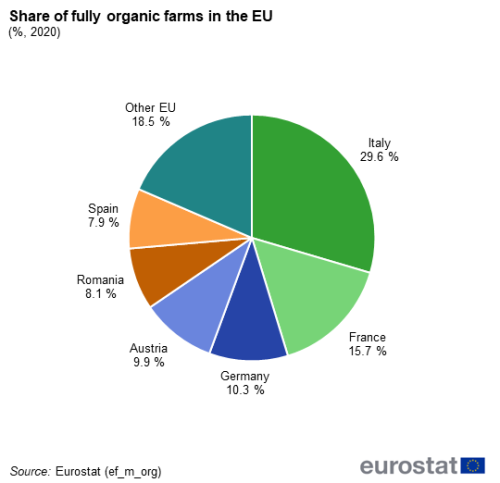Fully organic farms in the EU
Data extracted in March 2024
Planned article update: March 2034
Highlights
There were 245 000 fully organic farms in the EU in 2020.
Between 2010 and 2020, the number of fully organic farms in the EU more than doubled.
Fully organic farms tend to be bigger than their non-organic counterparts.
Fully organic farms (% share of all farms in EU and each Member State, 2020)
Organic farming is an agricultural production method that aims to use natural substances and processes. It tends to limit the environmental impact of agriculture through a more responsible use of natural resources, allowing the maintenance of biodiversity and water quality, and the enhancement of soil fertility, as well as encouraging a high standard of animal welfare.
This article provides a snapshot of the structure of organic agriculture in the European Union (EU), based on data from the 2020 Agricultural Census, which is conducted every ten years in the EU. The article is focused on those farms that are fully organic. That is to say that, for the purpose of this article, an organic farm either has all of their utilised agricultural area (UAA) and / or all their livestock fully converted or under conversion to organic farming.
It should be noted that there are also farms that have partially converted to organic farming (e.g. some of their UAA is under organic production but some is not) or are partially under conversion. This gives an indication of farms that will become fully converted in the near future, but these are not covered in this article[1] . These partially organic farms are covered in the complementary article on developments in organic farming, which focuses on organic areas (organic arable area, organic permanent grassland and organic permanent crops) and also looks at organic livestock using annual organic production data provided by EU countries under legal obligation. Comparisons between the two data sources (the Agricultural Census and annual organic production data) should be performed with caution, due to differences in definitions, variables and concepts.
Whilst this article is focused on fully organic farms, comparisons are made with all farms. Fuller analysis on all farms is available in the article on farms and farmland in the European Union - statistics.
Full article
Organic farms
There were 245 000 fully organic farms in the EU in 2020
There were 9.1 million agricultural holdings in the EU in 2020, of which 245 000 were holdings that were fully organic or fully under conversion to be organic[2] (hereafter named ‘fully organic farms’). These fully organic farms were the equivalent of 2.7% of all the EU's farms in 2020.
Almost 30 % of these fully organic farms were found in Italy, the next highest proportions being in France (15.7 %) and Germany (10.3 %) – see Figure 1.
The uptake of organic farming was more pronounced in some EU countries than others (see Figure 2). The highest share of fully organic farms was in Austria (21.8 % of all farms), followed by Estonia (16.4 %) and Czechia (15.4 %). Fully organic farms represented less than 0.5 % of all the farms in Hungary, Poland[3] and Malta.
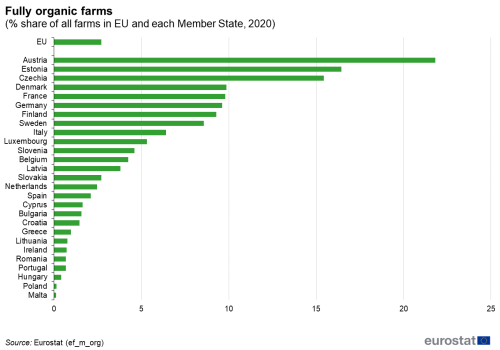
(% share of all farms in EU and each Member State, 2020)
Source: Eurostat (ef_m_org)
Between 2010 and 2020, the number of fully organic farms in the EU more than doubled
In the decade between 2010 and 2020, the EU lost 3.0 million farms. However, the number of fully organic farms more than doubled (+223 %), with an additional 135 000 farms having converted completely or in the process of complete conversion. Of these additional farms, the majority were in Italy (an additional 47 000 farms), France (an additional 31 000 farms) and Romania (an additional 19 000 farms). With the exception of two EU countries (Poland[4] and Greece), the number of organic farms rose between 2010 and 2020.
Organic farm specialisation
Much higher proportion of fully organic farms are livestock specialists than is the case for all farms
The diversity of farm types can be shown according to what is grown or reared, based on whether there is a single dominant activity or not. A farm is considered to be specialised when a particular activity provides at least two-thirds of the production or the business size of an agricultural holding. Others have a mix of activities in which no one activity dominates.
Some farms are specialised in crop production, whether that be where field crop activities are the dominant activity, or where permanent crops (like apples, grapes and olives) dominate, or indeed horticultural activities. Some farms are specialised in animal production and animal products, whether that be where grazing livestock or granivores (such as pigs and poultry) dominate. Other farms have a mix of crops, mix of livestock, or mix of crops and livestock.
A majority of the EU’s 245 000 fully organic farms in 2020 were specialised in crop production (53.8 %). This was less than the corresponding share of all EU farms that specialised in crop production (58.3 %) – see Figure 3. Within crop specialists, there was a much lower proportion of cereals, oilseed and protein crop specialists in organic farming than all across all farms (8.3 % vs 15.9 %) but a far higher proportion of organic fruit and citrus fruit farms (9.1 % vs 5.5 % across all farms) and vineyards (7.8 % vs 4.7 % across all farms).
One third of organic farms in the EU (33.0 %) were livestock specialists in 2020. This was much higher than the corresponding share of all EU farms that were livestock specialists (21.7 %). This higher share principally reflected much higher shares of specialist organic cattle-rearing and fattening farms (12.6 % vs 4.3 % across all farms) and specialist organic dairying farms (8.8 % vs 5.2 %).
Mixed farms represented a much lower share of organic farms (13.0 %) than across all farms in the EU (19.3 %) in 2020.

(% share of fully organic farms, EU, 2020)
Source: Eurostat (ef_m_org)
Between 2010 and 2020, a sharp increase in organic general field cropping farms
Of the additional 135 000 farms in the EU that became fully organic between 2010 and 2020, a majority (85 000 farms) were crop specialists. There were higher numbers of fully organic farms specialising in every type of agriculture, with the single exception of specialists in cattle-dairying, rearing and fattening combined.
There were an additional 24 000 fully organic farms specialising in general field cropping in 2020 compared with 2010. Among others, this was followed by an additional 15 000 fully organic farms specialising in vineyards, 14 000 additional fully organic farms specialising in cattle-rearing and fattening, 14 000 additional fully organic farms specialising in fruit and citrus fruit, as well as 13 000 additional fully organic farms specialising in cereal, oilseed and protein crops.
Farm size
Fully organic farms tend to be bigger than their counterparts
The average mean size of a fully organic farm in the EU was 42.9 hectares (ha) in 2020, substantially more than the average for all farms in the EU (17.4 ha). There was a considerable difference in size distribution too. A little over one fifth (22.5 %) of all fully organic farms were more than 50 ha in size compared with just 7.5 % of all the EU’s farms (see Figure 4). Indeed, only about one quarter (27.7 % of fully organic farms) were smaller than 5 ha in size compared with almost two-thirds of all the EU’s farms. Fully organic farms of over 50 ha worked three-quarters (76 %) of the EU’s organic utilised agricultural area, a slightly higher proportion than for all the EU’s farms over 50 ha in size.
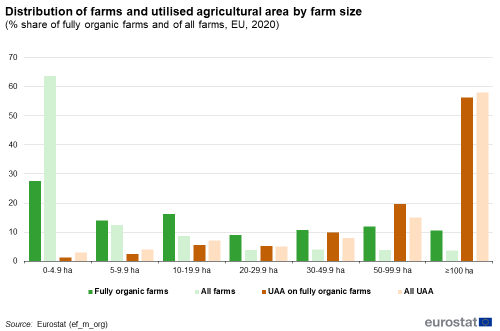
(% share of fully organic farms and of all farms, EU, 2020)
Source: Eurostat (ef_m_org)
Fully organic farms greater than 20 ha in size represented 7.6 % of all farms above that size (see Figure 5 for a breakdown by size class). This was a notably higher share than among smaller farms; only 1.8 % of all farms under 20 ha in size were fully organic farms. Overall, fully organic farms represented 2.7 % of all the EU's farms.

(% share of all farms in each size class, EU, 2020)
Source: Eurostat (ef_m_org)
A small group of large, fully organic farms are responsible for one half of the standard output from fully organic farming in the EU.
Broadly-speaking, there are three distinct groups of farms in the EU:
- semi-subsistence farms, where the focus is on growing a high proportion of food to feed farmers and their families
- small and medium-sized farms that are generally family-run businesses, and
- large agricultural enterprises which are more likely to have a legal form or be cooperatives.
These distinctions are made clearer by analysing farms in terms of their economic size, which in the farm structure statistics is represented by the farm’s standard output.
Of the EU's quarter of a million fully organic farms in 2020, 9.0 % had a standard output below €2 000 per year and were responsible for only 0.1 % of the EU's total standard output from fully organic farms (see Figure 6). These very small farms are typically at the (semi-)subsistence end of the farming scale, consuming a significant proportion of their own production.
A further 14.3 % of fully organic farms had a standard output within the range of €2 000 - €8 000 per year. Together these very small and small farms accounted for 23.3 % of the EU’s organic farms, a much lower proportion that for all the EU’s farms (63.7 %) in 2020.
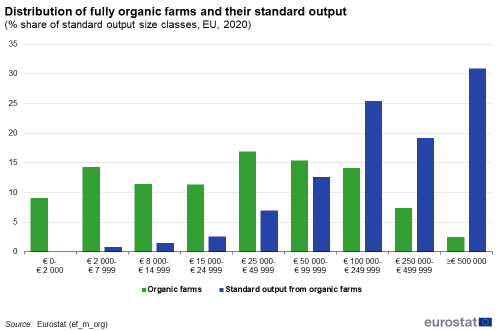
(% share of standard output size classes, EU, 2020)
Source: Eurostat (ef_m_org)
In contrast, about 18 000 fully organic farms that each had a standard output of at least €250 000 in 2020 were responsible for one half (50.0 %) of all the standard output from organic farming. Fully organic farms are of all sizes and economic activity, but as with non-organic farms, it is a relatively small number of large farms that produce the most standard output.
Profiles of managers of fully organic farms
Like all farms in the EU, most fully organic farms are managed by men
Farm managers are those responsible for the normal daily financial and production routines of running a farm. As such, they can be thought of as farmers; they make the decisions on what to plant or how many livestock to rear, just as much as when to buy materials and sell stock. In farm structure statistics, only one person per farm can be identified as a farm manager. Often the farm manager is also the holder of the farm but this need not be the case especially when the farm has a legal form.
Almost three-quarters (73.1 %) of the managers of fully organic farms were male in 2020, a higher proportion than for all the EU’s farms (68.4 % - see the Statistics Explained article on farmers and the agricultural labour force - statistics).
The gender imbalance among farmers was even stronger in organic farming; women farm managers represented just 26.9 % of all managers of fully organic farms compared with 31.6 % on all farms. They were particularly scarce in the Netherlands (just 7.7 %, although this was a slightly higher share than on all farms) but more common on organic farms in Latvia (38.9 %), Bulgaria (37.5 %), Austria (36.3 %) and Romania (36.2 %).
Unlike all farms, most fully organic farms are run by managers under 55 years of age; indeed, 20.7 % were under 40 years old.
Farm managers of fully organic farms tended to be slightly younger than across all EU farms. Whereas a majority (57.6 %) of all farm managers (both sexes combined) were at least 55 years of age in 2020, a much lower proportion (42.7 %) of managers of fully organic farms were at least 55 years old. Conversely, there was a much higher proportion of young managers of fully organic farms; organic farm managers under 40 years old represented almost 20.7 % of all managers of fully organic farms (see Figure 7), compared with just 11.9 % of all farm managers.
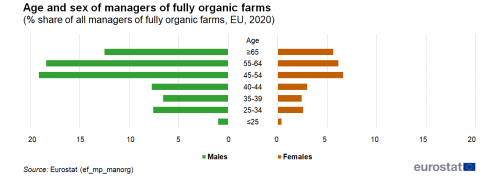
(% share of all managers of fully organic farms, EU, 2020)
Source: Eurostat (ef_mp_manorg)
Almost one quarter (23.6 %) of managers of fully organic farms had full agricultural training, which was a much higher share than for all farms (10.2 %).
Managers of farms have different levels of training; there are those with basic training, those with practical experience and those with full agricultural training. This mix was more evenly distributed among the managers of fully organic farms than managers of all the EU’s farms. One third (33.5 %) of the EU’s managers of fully organic farms in 2020 had basic training, a much higher proportion than for all farms (17.5 %). This higher proportion for fully organic farm managers was common to every age category. Conversely, almost one quarter (23.6 %) of managers of fully organic farms had full agricultural training, which was a much higher share than for all farms (10.2 %). Again, this higher proportion for managers of fully organic farms was common across age categories. Managers with only practical experience represented a much lower share (42.9 %) of managers of fully organic farms, than they did for all the EU’s farms (72.4 %).
The proportion of managers of fully organic farms with only practical experience rose through each higher age category (see Figure 8). One quarter of those under 35 years of age only had practical experience of farming, which rose to two-thirds (67.6 %) of managers over 65 years of age. By contrast, the proportion of managers of fully organic farms with full agricultural training tended to be higher in younger age classes. Whereas only 8.1 % of managers aged over 65 years of age had full agricultural training, this share rose to 35.6 % among managers aged between 25 to 34 years of age.
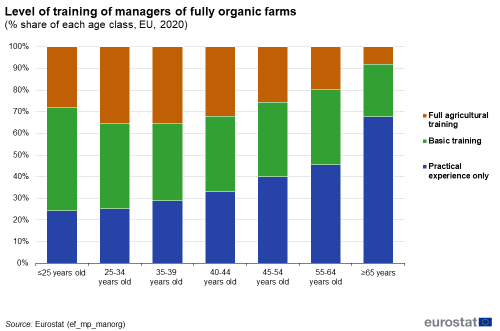
(% share of each age class, EU, 2020)
Source: Eurostat (ef_mp_manorg)
A few EU countries had relatively high proportions of managers of fully organic farms with full agricultural training, in particular the Netherlands (74.6 %, compared with 62.6 % for managers of all farms), France (53.9 %, compared with 38.4 % across all farms), and Latvia (50.4 %, compared with 29.6 % across all farms). By contrast, the proportion of managers of fully organic holdings with full agricultural training was particularly low in Romania (1.5 %, compared with 0.7 % across all farms).
Source data for tables and graphs
Data sources
Farm Structure (FS) data are collected from agricultural censuses every ten years and from sample surveys every 3 or 4 years in between. The main tables from the Agricultural Census for 2020 are gradually being published and are used in this analysis.
Context
Farming is an activity that is about growing crops and raising livestock. It is the business of providing key primary ingredients for the food that we eat and much of what we drink. Farming draws on a set of resources to produce these agricultural goods, as well as agricultural services. These resources or 'factors of production' can be broadly categorised as land, labour, knowledge, capital and entrepreneurship. Within the EU, the farming sector operates under the Common Agricultural Policy (CAP). Just as agriculture needs to keep pace with scientific and technological advances, so the CAP needs to respond to developing challenges. The CAP has been reformed a number of times over the years. On 2 December 2021, the European Commission proposals for further changes beyond 2020 were adopted and entered into force on 1st January 2023. The nine objectives of this new CAP highlight the central role of farms and farmers in meeting challenges to do with climate change, with creating vibrant rural areas, with preserving rural landscapes, with environmental care and with protecting food and health quality. These economic, environmental and climate-related and socio-economic challenges require that farmers be at the heart of Europe's rural communities. This helps explain why organic farming is important as a key driver within the EU’s biodiversity strategy for halting biodiversity loss and building a healthy and sustainable food system.
Direct access to
See also
Main tables
- Main farm indicators by NUTS2 regions (ef_mainfarm)
- Farmland use indicators by NUTS2 regions (ef_landuse)
- Farm livestock (ef_livestock)
- Management and practices (ef_mp)
Dedicated section
Methodology
To better understand the structure of organic farms in Europe, Eurostat has developed a new indicator focusing on both agricultural land and animal production. It deviates from the CAP policy context indicator (C19 agricultural area under organic farming), accounting solely for agricultural land in organic farming.
An organic farm is defined as an agricultural holding having all utilised agricultural land (excluding kitchen gardens) either converted or under conversion to organic farming or the entire animal production is organic (under conversion/converted). A non-organic farm refers to an agricultural holding that does not apply organic production method. A partially organic and non-organic farm reflects an agricultural holding with mixed agricultural production methods, while having a part of their land converted or under conversion to organic, but not the entire land, or having a share of animal production converted or under conversion to organic, but not the entire stock. Note that this new indicator is applied in the tables (ef_m_org) and (ef_mp_manorg).
The Standard Output (SO) of an agricultural product (crop or livestock), is the average monetary value of the agricultural output at farm-gate price, in euro per hectare or per head of livestock. There is a regional SO coefficient for each product, as an average value over a reference period (5 years, except for the SO 2004 coefficient calculated using the average of 3 years). The sum of all the SO per hectare of crop and per head of livestock in a farm is a measure of its overall economic size, expressed in euro. The standard output is used to classify agricultural holdings by type of farming and by economic size, but it does not differentiate between organic and non-organic production methods. Therefore, the current analysis is limited when comparing fully organic farms to all farms in terms of their economic size as it is assumed that SO coefficient is the same for an organic and non-organic product.
Legislation
- Regulation 1166/2008 of the European Parliament and of the Council on farm structure surveys and the survey on agricultural production methods (farm structure survey from 2010 to 2016)
- Summaries of EU Legislation: EU integrated farm statistics
- Commission Regulation No 715/2014 of 26 June 2014 amending Annex III to Regulation (EC) No 1166/2008 of the European Parliament and of the Council on farm structure surveys and the survey on agricultural production methods, as regards the list of characteristics to be collected in the farm structure survey 2016
Implementing legislation
- Commission Regulation 1200/2009 implementing Regulation 1166/2008 on farm structure surveys and the survey on agricultural production methods (farm structure survey from 2010 to 2016)
- Commission Regulation 2015/1391 amending Regulation (EC) No 1200/2009
- Commission Implementing Regulation (EU)2018/1874 of 29 November 2018 on the data to be provided for 2020 under Regulation (EU) 2018/1091 of the European Parliament and of the Council on integrated farm statistics and repealing Regulations (EC) No 1166/2008 and (EU) No 1337/2011, as regards the list of variables and their description (Text with EEA relevance.)
Related and older legislation
- Council Regulation 1217/2009 setting up a network for the collection of accountancy data on the incomes and business operation of agricultural holdings in the European Community
- Summaries of EU Legislation: Farm incomes and operations - EU statistics
- Commission Delegated Regulation 1198/2014 of 1 August 2014 supplementing Council Regulation (EC) No 1217/2009 setting up a network for the collection of accountancy data on the incomes and business operation of agricultural holdings in the European Union
- Commission Implementing Regulation 220/2015 of 3 February 2015 laying down rules for the application of Council Regulation (EC) No 1217/2009 setting up a network for the collection of accountancy data on the incomes and business operation of agricultural holdings in the European Union
- Council Regulation (EC) No 834/2007 of 28 June 2007 on organic production and labelling of organic products and repealing Regulation (EEC) No 2092/91
- Regulation (EU) No 2018/848 of the European Parliament and of the Council of 30 May 2018 on organic production and labelling of organic products and repealing Council Regulation (EC) No 834/2007
Policy legislation
External links
Notes
- ↑ The Agricultural Census of 2020 also recorded partially organic farms: there were 35 870 farms in the EU that had converted a part of their UAA to organic farming and also 45 000 farms that were underway with conversion to organic farming on a part of their utilised agricultural area.
- ↑ All the utilised agricultural area (UAA) of these farms is organic and /or their entire livestock production is fully converted or under conversion to organic farming.
- ↑ This might be partly explained by the thresholds applied in the 2020 Agricultural Census.
- ↑ Poland introduced new thresholds for 2020 and amended others, which may explain the apparent decline in fully organic farm numbers between 2010 and 2020.
